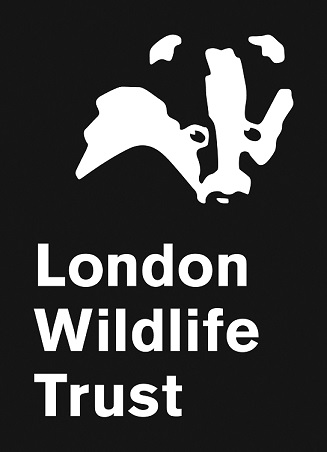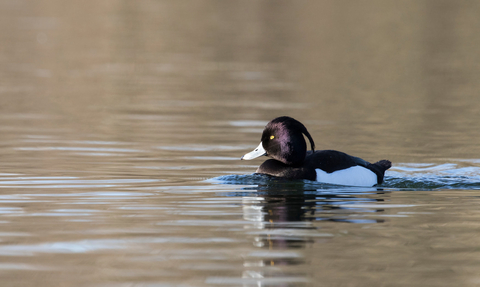
Tufted duck credit Chris Lawrence
Wildlife at Woodberry Wetlands
Woodberry Wetlands supports lots of species throughout the year, from wintering populations of pochard, shoveler, tufted and gadwall ducks, to reed warbler and bunting who have migrated from Africa for spring and summer. But it’s not just great for birds...
Birds and Waterfowl
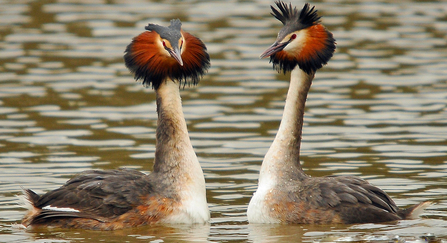
Great crested grebe credit Steve Waterhouse
London has recorded over 365 species of bird within a 20-mile radius of St. Paul’s Cathedral. From the parks and green spaces of Central London to the reservoirs and gravel pits in the North and West and the estuary and the salt marshes in the East.
April-May
When the wintering birds begin to disappear and the last of the siskins, bramblings, redwings, fieldfares, water rails and green sandpipers and most of the gulls have departed, trans-Saharan migrants such as swallows and house and sand martins make their long-awaited return. Common swifts congregate in large numbers alongside commonly sighted residents blackcaps and common chiffchaffs. Five species of warbler, including the lesser & common whitethroats and garden warblers, arrive with the reservoir’s breeding varieties of reed and sedge warbler in April.
Common terns are a regular presence with the possibility of seeing arctic terns due to the favourable fishing opportunities. Two main species, the common buzzard and red kites, dominate the sky during Spring with marsh harriers and ospreys being more rare but annual visitors. Other notable sightings and unexpected visitors to the reservoir conditions dependent have included: redshank, northern lapwing, little ringed plover, whinchat, water pipit, firecrest, brambling, shelduck, snipe and northern lapwing.
During May, some escaped species, including budgerigars, African grey parrot and cockatiel, have been spotted on the run in the wetlands area. Raptors, mainly represented by our two resident species kestrel and sparrowhawk, are also a feature over the skies.

Siskin credit Margaret Holland
May-June
June and July are generally quiet from a migratory perspective, hence, the summer is a good time to enjoy the breeding species, of which at least 50 of which have bred regularly at the reservoir in the last few years. The wetland habitat provides nesting sites for a good variety of waterbirds, including coot, moorhen, mallard, tufted duck, mute swan, Canada goose, little grebe, common pochard, great crested grebe and our only nesting larid the lesser black-backed gull.
Both kestrel and sparrowhawk breed in the vicinity and stock doves, green & great spotted woodpeckers, pied & grey wagtails breed close by and are a familiar sight in the summer. Blackcaps have increased as a breeding species in the local area and Cetti’s, reed & sedge warblers and Reed Buntings nest exclusively in the reed bed at the East Reservoir whilst bullfinch, greenfinch, chaffinch, common chiffchaffs, common whitethroats, kingfishers, goldcrests, long-tail & coal tits breed within the perimeter.
Bats
The pipistrelle is the most common species of bat in Britain and can eat up to 3,000 small insects in a night. They can be seen after dusk in woodland, over water and along hedgerows in almost every part of London.
The noctule is one of the largest bats found in Britain, it has a sleek golden coloured fur and broad brown ears. Although still fairly widespread in London, the species has declined in recent years, possibly due, in part, to over management of trees where it exclusively roosts in woodpecker or rot holes. The noctule feeds on moths, beetles and mayflies and typically feeds high over woodland, parkland and water bodies.
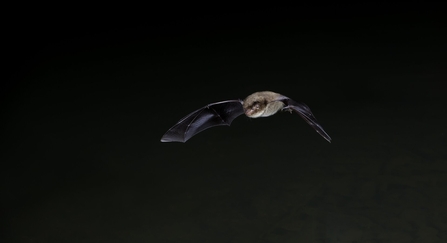
© Dale Sutton/2020vision
Daubenton’s bat is similar to the natterer’s and is often called the water bat due to its level flight pattern above the surface of water bodies such as lakes. It feeds on small flies such as caddisflies and midges and roosts in trees, tunnels and bridges which are generally near water.
Leisler’s bat is slightly smaller than the common noctule. Its face, ears and wings are dark and its fur is brown. The undersides of the arms are hairy giving it the alternative name “hairy-armed bat”.
Natterer’s bat is medium-sized with short, dense fur on the upper surface of head, a greyish-brown outer body and whitish-grey ventral surface with smoky grey ears and wing membranes. The ears and the wing membranes are smoky grey. It feeds on small insects and other invertebrates which it catches on the wing or pursues on the ground. In summer it roosts in deciduous and coniferous trees, structures or bat boxes close to its feeding habitats.
The brown long-eared bat has remarkably large ears which are nearly as long as its body. It is most frequently found roosting inside roof spaces where it likes the ridge beams of older properties. It emerges very late when it is quite dark and keeps close to trees when hunting making it difficult to spot even when it’s definitely there.
Invertebrates and Amphibians
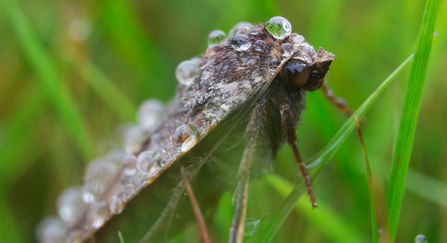
Large yellow underwing credit Chris Lawrence
The reserve proffers the opportunity to observe such distinctive moths as the sizeable black and white spotted leopard moth and large yellow underwing with a wingspan of 5 – 6 centimetres and the more petite small magpie and literally clear-winged red-tipped clearwing to the more common members of the Tortricidae family, tortrix, clover seed and holly tortrix moths, and the micro moths of the Eriocraniidae, Gracillariidae, Momphidae and Oecophoridae families.
The butterflies that you will most likely spot are the orange and brown winged large and Essex skippers. Holly blue, identified by their bright blue upperwings and pale blue spotted undersides, the very handsome purple hairstreak and common blue. The peacock with its red wings and brilliant eyespots and striking orange and black patterned small tortoiseshell are amongst the most spectacularly coloured and easily spotted of the Nymphalidae family whilst the meadow brown, speckled wood and red admiral are also present.
Woodberry Wetlands is an excellent place to see dragonflies and damselflies in the summer months, including the rare red-eyed damselfly. Hoverflies, such as the distinctive marmalade fly, are frequent visitors too.
There are also healthy populations of smooth newt, common frog and common toad across the site, which provides excellent breeding and foraging habitat for amphibians.
Habitat
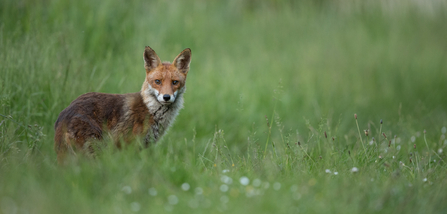
Fox in the grass at Woodberry Wetlands credit Penny Dixie
Reedbed
Over the last century, the reservoir has become shallower, now 2m from its original depth of up to 6m, and there is around about 4m worth of silt which the New River has primarily deposited. The silting up of the reservoir has created undulations to form pools, islands and channels and allowing the existing reedbed to spread out further from the edge, benefiting a huge range of wildlife.
The reedbeds surrounding the reservoir are rich in wetland wildlife. These have been increased in size by London Wildlife Trust with movement of silt and planting to be enhanced for its wildlife, birds in particular.
The reedbed habitat is dominated by common reed with patches of bramble, curled dock and common nettle found throughout the reedbed. Invasive species such as Japanese knotweed and orange balsam were treated before works started to avoid potential distribution of these species.
Hedgerow
Hedgerows provide important habitat for mammals, birds and invertebrates on the site. Hawthorn is the principal component of the hedgerows at Woodberry Wetlands, with its blossom providing a nectar source for pollinators and its structure sheltering foodplants of butterflies.
Grassland
There is an area of improved grassland on the top of the embankments and semi-improved grassland and tall herbs on the south-facing slope next to the reedbed. This is reflected in the dominant grass species on the site which are species associated with higher-nutrient environments: meadow foxtail, barren brome, red fescue, Yorkshire fog, wall barley and perennial rye-grass.
Wildflower meadow
An area of wildflower meadow has been created, supporting species such as meadow vetchling, greater bird’s-foot trefoil and lesser trefoil.
Orchard
The orchard is planted with traditional English fruit varieties including Victoria plum, conference pear and James Grieve apple. The James Grieve variety was formerly a fruit market staple that has been forgotten by many people. It bruises easily and so it is not considered to be suitable for modern supermarket handling. As they mature, the orchard trees will provide vital habitat for invertebrates.
